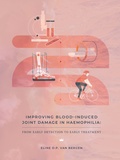Improving blood-induced joint damage in haemophilia
From early detection to early treatment

Bergen, Eline van
- Promoter:
- Prof.dr. R.E.G. (Roger) Schutgens & prof.dr. F.P.J.G. (Floris) Lafeber
- Co-promoter:
- Dr. L.F.D. (Lize) van Vulpen & dr. S.C. (Simon) Mastbergen
- Research group:
- Lafeber
- Date:
- February 2, 2023
- Time:
- 16:15 h
Summary
The inherited coagulation disorder haemophilia is characterized by spontaneous and trauma-related bleeding. Recurrent joint bleeds leading to synovial inflammation and osteochondral damage cause major morbidity amongst patients with haemophilia. The current treatment strategy focuses on preventing joint bleeds and subsequent haemophilic arthropathy. Although prophylactic clotting factor replacement therapy has led to a significant decrease in joint bleeds, (subclinical) bleeding can not be prevented completely. The early detection and early initiation and adaptation of treatment is of utmost importance to prevent (irreversible) progression of arthropathy.
This thesis aimed to provide a broader insight in the abilities of early detection and early treatment of haemophilic arthropathy. The early detection part focused on the occurrence and detection of subclinical joint changes by imaging and biochemical markers. The occurrence of subclinical blood-related and inflammatory joint changes in the six major synovial joints (ankles, knees, elbows) was evaluated by ultrasound in a cross-sectional study including patients without recent joint bleeds or complaints. Two systematic reviews were conducted to identify biochemical markers sensitive to joint changes in haemophilia and promising biochemical markers were selected and evaluated in the cross-sectional study. Besides, a subset of patients with lifelong access to prophylaxis and a joint without a history of bleeding, was also evaluated for signs of previous subclinical bleeding on magnetic resonance imaging (MRI). The early treatment part focused on treatment modalities that can prevent further joint damage and subsequent major orthopaedic interventions. As a first step, the safety regarding adverse bleeding and cardiovascular events in patients with haemophilia using (non-) selective non-steroidal anti-inflammatory drugs (NSAIDs) was systematically summarized. Next, a prospective pilot study was conducted investigating the clinical and structural changes after ankle joint distraction (AJD).